2006 Hyundai Terracan stop start
[x] Cancel search: stop startPage 91 of 539

1
FEATURES OF YOUR HYUNDAI
77
B390A01E-AAT Rear Window Wiper and Washer Switch
1. : The rear window wiper starts to operate three times after the washer fluid sprays onto the rear window.
2.OFF
3.INT: The interval between wipes op-
erates every 5 seconds inter-mittently.
4.ON : The rear window wiper starts
to operate continuously.
5. : The washer fluid will be sprayed
onto the rear window and the wiper operates while the rear window wiper barrel is placedin this position.
HHP2108 NOTE: Do not operate the washer continu- ously for more than 15 seconds or when the fluid reservoir is empty;this could damage the system. Do not operate the wiper when the win- dow is dry; this can result in scratch-ing as well as premature wiper blade wear. For the same reason, do not oper-ate the washer when the washer fluid reservoir is empty.
HAZARD WARNING SYS- TEM
B370A01A-AAT The hazard warning system should be used whenever you find it necessary to stop the car in a hazardous location. When you must make such an emer- gency stop, always pull off the road asfar as possible. The hazard warning lights are turned on by pushing in the hazard switch.This causes all turn signal lights to blink. The hazard warning lights will operate even though the key is not inthe ignition. To turn the hazard warning lights off, push the switch a second time. B370A01HP
Page 110 of 539
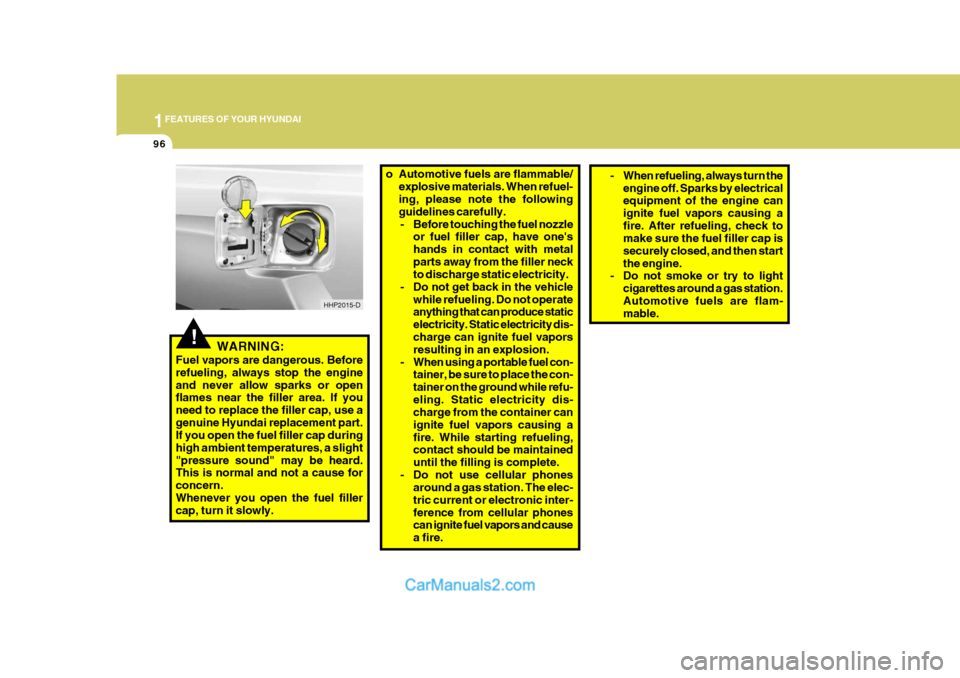
1FEATURES OF YOUR HYUNDAI
96
!WARNING:
Fuel vapors are dangerous. Before refueling, always stop the engineand never allow sparks or open flames near the filler area. If you need to replace the filler cap, use agenuine Hyundai replacement part. If you open the fuel filler cap during high ambient temperatures, a slight"pressure sound" may be heard. This is normal and not a cause for concern.Whenever you open the fuel filler cap, turn it slowly. HHP2015-D
o Automotive fuels are flammable/
explosive materials. When refuel-ing, please note the following guidelines carefully.- Before touching the fuel nozzle or fuel filler cap, have one'shands in contact with metalparts away from the filler neck to discharge static electricity.
- Do not get back in the vehicle
while refueling. Do not operateanything that can produce static electricity. Static electricity dis- charge can ignite fuel vapors resulting in an explosion.
- When using a portable fuel con- tainer, be sure to place the con-tainer on the ground while refu-eling. Static electricity dis- charge from the container can ignite fuel vapors causing afire. While starting refueling, contact should be maintained until the filling is complete.
- Do not use cellular phones around a gas station. The elec-tric current or electronic inter-ference from cellular phones can ignite fuel vapors and cause a fire. - When refueling, always turn the
engine off. Sparks by electrical equipment of the engine can ignite fuel vapors causing afire. After refueling, check to make sure the fuel filler cap is securely closed, and then startthe engine.
- Do not smoke or try to light
cigarettes around a gas station.Automotive fuels are flam- mable.
Page 162 of 539
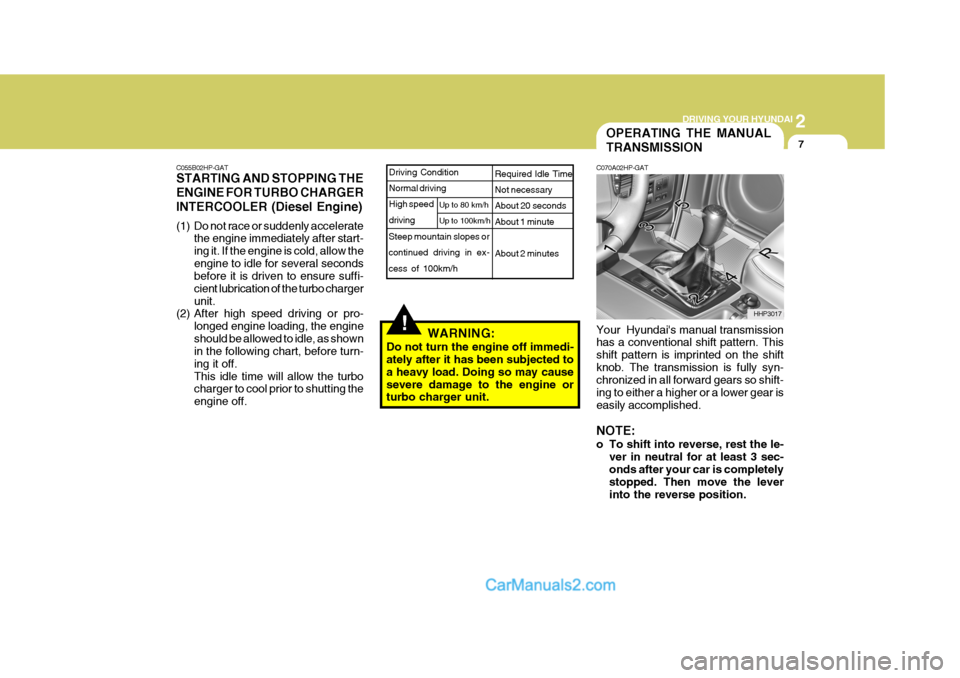
2
DRIVING YOUR HYUNDAI
7
C055B02HP-GAT STARTING AND STOPPING THE ENGINE FOR TURBO CHARGERINTERCOOLER (Diesel Engine)
(1) Do not race or suddenly accelerate the engine immediately after start- ing it. If the engine is cold, allow theengine to idle for several seconds before it is driven to ensure suffi- cient lubrication of the turbo chargerunit.
(2) After high speed driving or pro-
longed engine loading, the engineshould be allowed to idle, as shown in the following chart, before turn- ing it off.This idle time will allow the turbo charger to cool prior to shutting the engine off.OPERATING THE MANUAL TRANSMISSION
!WARNING:
Do not turn the engine off immedi- ately after it has been subjected to a heavy load. Doing so may causesevere damage to the engine or turbo charger unit. Steep mountain slopes or continued driving in ex- cess of 100km/h
Required Idle Time Not necessary About 20 secondsAbout 1 minute About 2 minutes
Driving Condition Normal driving High speed driving
Up to 80 km/h Up to 100km/hC070A02HP-GAT Your Hyundai's manual transmission has a conventional shift pattern. This shift pattern is imprinted on the shiftknob. The transmission is fully syn- chronized in all forward gears so shift- ing to either a higher or a lower gear iseasily accomplished. NOTE:
o To shift into reverse, rest the le-
ver in neutral for at least 3 sec- onds after your car is completely stopped. Then move the leverinto the reverse position.
HHP3017
Page 165 of 539

2 DRIVING YOUR HYUNDAI
10
!
C090B01HP-GAT The function of each position is as follows:
o P (Park): Use to hold the vehicle in place when parked or while starting the engine. Whenever parking the car, apply theparking brake and shift the selector lever to the "P" (Park) position.
CAUTION:
Never place the selector lever in the"P" (Park) position unless the ve- hicle is fully stopped.Failure to observe this caution will cause severe damage to the trans- mission. C090C01A-AAT
o R (Reverse): Use for backing up the vehicle. Bring the car to a complete stop before shifting the selector lever to "R" posi-tion. C090D01HP-GAT
o N (Neutral): In the "N" position, the transmission is in neutral, which means that no gearsare engaged. The engine can be started with the shift lever in "N" position, although this is not recommended ex-cept if the engine stalls while the car is moving.
C090E01HP-GAT
o D (Drive): Use for normal driving. The transmis- sion will automatically shift through a four-gear sequence, giving besteconomy and power. Never down-shift manually to "2" position or "L" position when vehicle speed is more than 96km/h (60 mph).
CAUTION:
Never shift into "R" or "P" positionwhile the vehicle is moving.
NOTE: Depress the brake pedal andpush the button when shifting. Push the button when shifting. The selector lever can beshifted freely.
For optimum fuel economy, acceler- ate gradually. The transmission will automatically shift to the second, thirdand overdrive gears.
!
Page 166 of 539
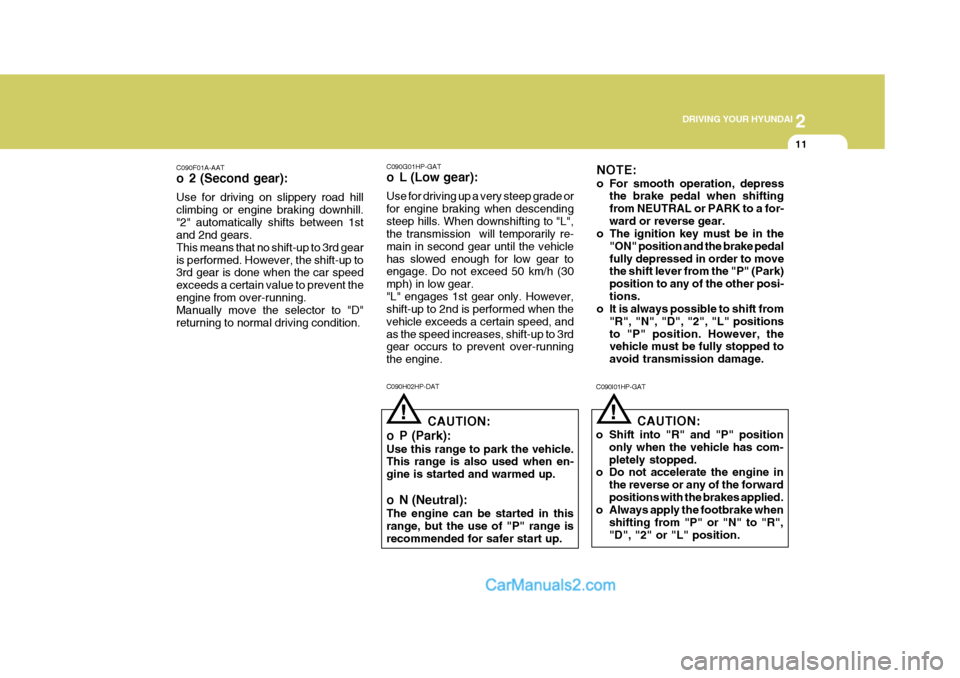
2
DRIVING YOUR HYUNDAI
11
!
C090F01A-AAT
o 2 (Second gear): Use for driving on slippery road hill climbing or engine braking downhill."2" automatically shifts between 1st and 2nd gears. This means that no shift-up to 3rd gearis performed. However, the shift-up to 3rd gear is done when the car speed exceeds a certain value to prevent theengine from over-running. Manually move the selector to "D" returning to normal driving condition.
C090G01HP-GAT
o L (Low gear): Use for driving up a very steep grade or for engine braking when descendingsteep hills. When downshifting to "L", the transmission will temporarily re- main in second gear until the vehiclehas slowed enough for low gear to engage. Do not exceed 50 km/h (30 mph) in low gear."L" engages 1st gear only. However, shift-up to 2nd is performed when the vehicle exceeds a certain speed, andas the speed increases, shift-up to 3rd gear occurs to prevent over-running the engine. C090H02HP-DAT
CAUTION:
o P (Park): Use this range to park the vehicle. This range is also used when en- gine is started and warmed up.
o N (Neutral): The engine can be started in this range, but the use of "P" range isrecommended for safer start up. NOTE:
o For smooth operation, depress
the brake pedal when shifting from NEUTRAL or PARK to a for-ward or reverse gear.
o The ignition key must be in the
"ON" position and the brake pedalfully depressed in order to move the shift lever from the "P" (Park) position to any of the other posi-tions.
o It is always possible to shift from
"R", "N", "D", "2", "L" positionsto "P" position. However, the vehicle must be fully stopped to avoid transmission damage.!
C090I01HP-GAT
CAUTION:
o Shift into "R" and "P" position only when the vehicle has com- pletely stopped.
o Do not accelerate the engine in
the reverse or any of the forwardpositions with the brakes applied.
o Always apply the footbrake when
shifting from "P" or "N" to "R","D", "2" or "L" position.
Page 177 of 539
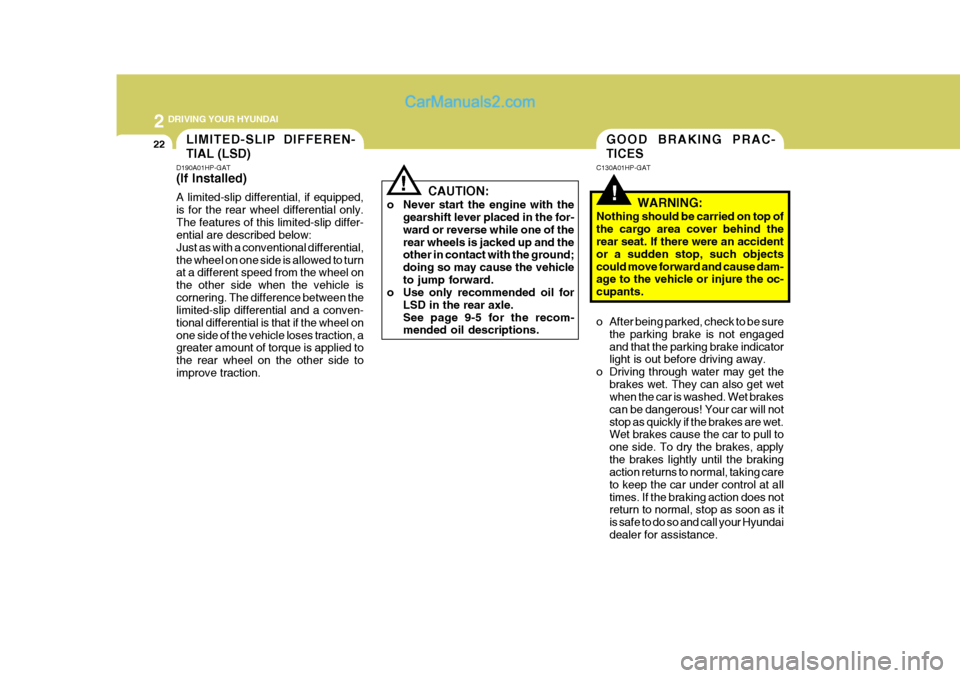
2 DRIVING YOUR HYUNDAI
22
!
C130A01HP-GAT
WARNING:
Nothing should be carried on top of the cargo area cover behind the rear seat. If there were an accident or a sudden stop, such objectscould move forward and cause dam- age to the vehicle or injure the oc- cupants.
o After being parked, check to be sure the parking brake is not engaged and that the parking brake indicator light is out before driving away.
o Driving through water may get the brakes wet. They can also get wetwhen the car is washed. Wet brakes can be dangerous! Your car will notstop as quickly if the brakes are wet. Wet brakes cause the car to pull to one side. To dry the brakes, applythe brakes lightly until the braking action returns to normal, taking care to keep the car under control at alltimes. If the braking action does not return to normal, stop as soon as it is safe to do so and call your Hyundaidealer for assistance.
GOOD BRAKING PRAC- TICES
LIMITED-SLIP DIFFEREN- TIAL (LSD)
D190A01HP-GAT (If Installed) A limited-slip differential, if equipped, is for the rear wheel differential only.The features of this limited-slip differ- ential are described below: Just as with a conventional differential,the wheel on one side is allowed to turn at a different speed from the wheel on the other side when the vehicle iscornering. The difference between the limited-slip differential and a conven- tional differential is that if the wheel onone side of the vehicle loses traction, a greater amount of torque is applied to the rear wheel on the other side toimprove traction. CAUTION:
o Never start the engine with the gearshift lever placed in the for-ward or reverse while one of therear wheels is jacked up and the other in contact with the ground; doing so may cause the vehicleto jump forward.
o Use only recommended oil for
LSD in the rear axle.See page 9-5 for the recom- mended oil descriptions.
!
Page 178 of 539
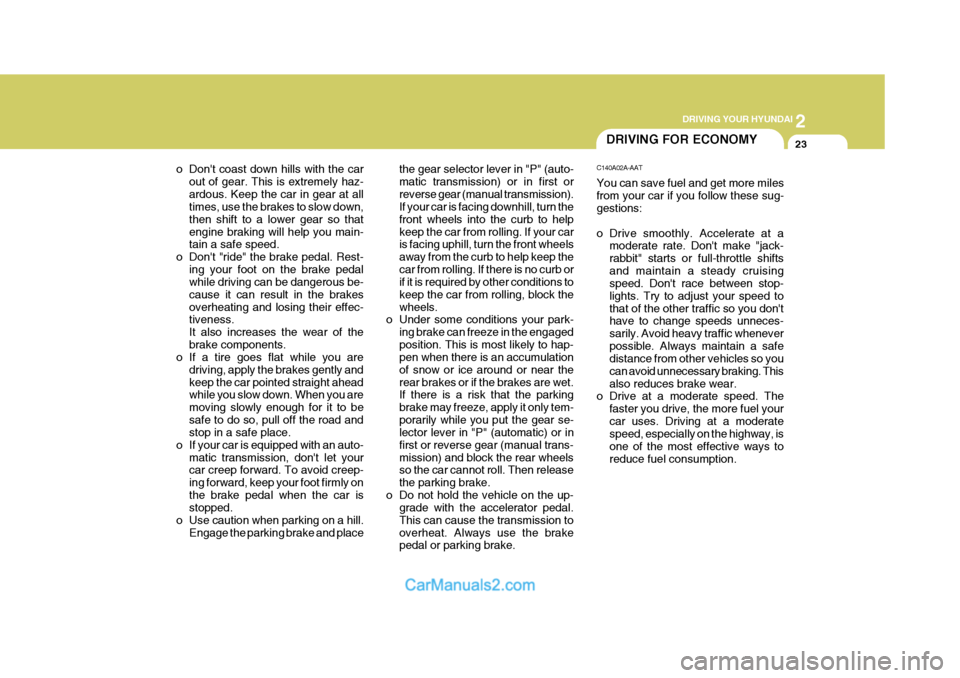
2
DRIVING YOUR HYUNDAI
23
o Don't coast down hills with the car out of gear. This is extremely haz- ardous. Keep the car in gear at all times, use the brakes to slow down, then shift to a lower gear so thatengine braking will help you main- tain a safe speed.
o Don't "ride" the brake pedal. Rest- ing your foot on the brake pedalwhile driving can be dangerous be- cause it can result in the brakesoverheating and losing their effec- tiveness. It also increases the wear of thebrake components.
o If a tire goes flat while you are
driving, apply the brakes gently andkeep the car pointed straight ahead while you slow down. When you are moving slowly enough for it to besafe to do so, pull off the road and stop in a safe place.
o If your car is equipped with an auto- matic transmission, don't let yourcar creep forward. To avoid creep- ing forward, keep your foot firmly onthe brake pedal when the car is stopped.
o Use caution when parking on a hill. Engage the parking brake and place the gear selector lever in "P" (auto- matic transmission) or in first orreverse gear (manual transmission). If your car is facing downhill, turn the front wheels into the curb to helpkeep the car from rolling. If your car is facing uphill, turn the front wheels away from the curb to help keep thecar from rolling. If there is no curb or if it is required by other conditions to keep the car from rolling, block thewheels.
o Under some conditions your park-
ing brake can freeze in the engagedposition. This is most likely to hap- pen when there is an accumulation of snow or ice around or near therear brakes or if the brakes are wet. If there is a risk that the parking brake may freeze, apply it only tem-porarily while you put the gear se- lector lever in "P" (automatic) or in first or reverse gear (manual trans-mission) and block the rear wheels so the car cannot roll. Then release the parking brake.
o Do not hold the vehicle on the up- grade with the accelerator pedal.This can cause the transmission tooverheat. Always use the brake pedal or parking brake.DRIVING FOR ECONOMY
C140A02A-AAT You can save fuel and get more miles from your car if you follow these sug- gestions:
o Drive smoothly. Accelerate at a moderate rate. Don't make "jack- rabbit" starts or full-throttle shiftsand maintain a steady cruising speed. Don't race between stop- lights. Try to adjust your speed tothat of the other traffic so you don't have to change speeds unneces- sarily. Avoid heavy traffic wheneverpossible. Always maintain a safe distance from other vehicles so you can avoid unnecessary braking. Thisalso reduces brake wear.
o Drive at a moderate speed. The
faster you drive, the more fuel yourcar uses. Driving at a moderate speed, especially on the highway, is one of the most effective ways toreduce fuel consumption.
Page 187 of 539

2 DRIVING YOUR HYUNDAI
32
!
CAUTION:
If overheating should occur when towing, (temperature gauge readsnear red zone), taking the following action may reduce or eliminate the problem.
1. Turn off the air conditioner.
2. Reduce highway speed.
3. Select a lower gear when going uphill.
4. While in stop and go traffic, place
the gear selector in park or neu- tral and idle the engine at a higher speed.
11. Avoid jerky starts, sudden accel-
eration or sudden stops.
12. Avoid sharp turns and rapid lane changes.
13. Avoid holding the brake pedal down too long or too frequently. This could cause the brakes to over- heat, resulting in reduced brakingefficiency.
14. When going down a hill, shift into a
lower gear and use the engine brak-ing effect. When ascending a long grade, downshift the transmission to a lower gear and reduce speedto reduce chances of engine over- loading and/or overheating.
15. If you have to stop while going uphill, do not hold the vehicle inplace by pressing on the accelera- tor. This can cause the automatictransmission to overheat. Use the parking brake or footbrake.
NOTE: When towing, check transmission fluid more frequently.